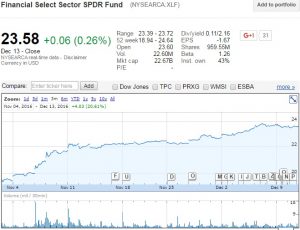Along with the recent bond sell-off, financials have had a huge run-up in the month since the election, up >20% from 11/4/2016 – 12/13/2016. At first glance, these two seem intricately linked, as higher interest rates may help the earnings of financials in general. Higher interest rates, however, do not necessarily mean there will be higher profit margins for banks.
Difference Between Issuers and Servicers
Ever since Fannie Mae was founded in 1938 in the wake of the Great Depression, there has been a robust secondary market for American conforming (FICO>680, <80% LTV) mortgages. Since then, secondary markets have flourished for all kinds of financial instruments, including auto loans, credit card balances and derivatives such as options and credit default swaps. Because of this, entire companies have flourished where their entire business plan is to originate loans and then sell them to the highest bidder. These companies usually make their money off of fees that stem from the origination of the loan and don’t earn money on the interest themselves.

Amazing 1-month return for financials
Contrast these companies with servicers: companies that hold and maintain loans, usually the company you call if you have an issue with a loan. These companies attempt to maximize their risk-adjusted net interest margin, and are mostly concerned with the spread between the cost of their funds and the revenue earned on their loans.
Refinance Boom
For the first group, issuers, the general trend of interest rates over the past 35 years has been fantastic for business. If you originated a loan in 2000, there is a good chance that you can get a lower interest rate today without you doing anything at all. Interest rates economy-wide are lower. Due to this, issuers have made a lot of loans helping consumers lower their burden along the way. This does not cut both ways, though. With fixed rate products, consumers will simply not refinance at all when interest rates rise. If interest rates continue to rise, may be the death knell for some of the weaker players in the industry.
Cost of Funds
For servicers and holder of adjustable-rate mortgages, your initial reaction may be that they will benefit from the increased revenue of higher interest rates. The key metric, however, is not the absolute interest rate but their relative interest rate. Banks often obtain a large amount of their funding base from deposits. Financial institutions have to pay customers for these deposits and often get the money from both their deposit base and financial markets:
Let’s take an oversimplified example (I’m assuming losses are 1.0% per year):
ROA | Cost of Funds | ||
1.0% | 5.0% | ||
Interest Rate | 4.0% | 1.95% | -1.93% |
| 6.0% | 3.91% | -0.01% | |
As you can see from the example above, higher interest rates does not necessarily mean that financial firms will make more per-loan. Add to this, fewer loans will be made and it might be a bit counter-intuitive that financials have reacted so positively at the same time that bonds have reacted so negatively.
Cheers,
Cameron Daniels
